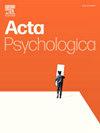Neural mechanisms of self-processing in autism: An ALE-based meta-analysis
IF 2.7
4区 心理学
Q2 PSYCHOLOGY, EXPERIMENTAL
引用次数: 0
Abstract
Self-processing in autism affects social interactions. By choosing 8 fMRI studies of autism spectrum disorder (ASD) self-processing, this study used ALE meta-analysis to investigate the brain underpinnings of self-processing in ASD. The findings revealed the following: (1) The capacity to make self-other distinctions and mirroring in social interactions is impacted by inadequate activation of brain areas of the mirror neuron system in ASD, which in turn impairs social interactions. (2) ASD activated more brain regions in self-processing than typically developing (TD) individuals. TD individuals exhibit activation in only one cluster during self-processing, while ASD individuals show activation in five distinct clusters. As shown by the fact that TD primarily activated the right frontal lobe when it came to self-processing, whereas ASD activated the limbic lobe, temporal lobe, hippocampus, amygdala, pontine gyrus, and a portion of the left frontal lobe. This study reveals the cognitive neural basis of autism's greater focus on the self. By clarifying these neurobiological disparities, we acquire a more profound comprehension of the processes that cause social disabilities in ASD. This insight could possibly guide the creation of focused treatments designed to enhance social performance and enhance the quality of life for those with ASD.
自闭症自我加工的神经机制:一项基于ale的元分析
自闭症患者的自我加工影响社会互动。本研究选取8项自闭症谱系障碍(ASD)自我加工的fMRI研究,采用ALE meta分析探讨ASD自我加工的大脑基础。研究结果表明:(1)ASD患者在社会交往中区分自我和镜像的能力受到镜像神经元系统脑区激活不足的影响,进而影响社会交往。(2)与正常发育个体相比,ASD激活了更多的自我加工脑区。TD个体在自我加工过程中只表现出一个集群的激活,而ASD个体在五个不同的集群中表现出激活。事实表明,当涉及到自我加工时,TD主要激活了右额叶,而ASD激活了边缘叶、颞叶、海马体、杏仁核、桥脑回和左额叶的一部分。这项研究揭示了自闭症更关注自我的认知神经基础。通过澄清这些神经生物学上的差异,我们对导致ASD社会障碍的过程有了更深刻的理解。这一发现可能会指导我们开发出针对性的治疗方法,以提高自闭症患者的社会表现和生活质量。
本文章由计算机程序翻译,如有差异,请以英文原文为准。
求助全文
约1分钟内获得全文
求助全文
来源期刊

Acta Psychologica
PSYCHOLOGY, EXPERIMENTAL-
CiteScore
3.00
自引率
5.60%
发文量
274
审稿时长
36 weeks
期刊介绍:
Acta Psychologica publishes original articles and extended reviews on selected books in any area of experimental psychology. The focus of the Journal is on empirical studies and evaluative review articles that increase the theoretical understanding of human capabilities.
 求助内容:
求助内容: 应助结果提醒方式:
应助结果提醒方式:


